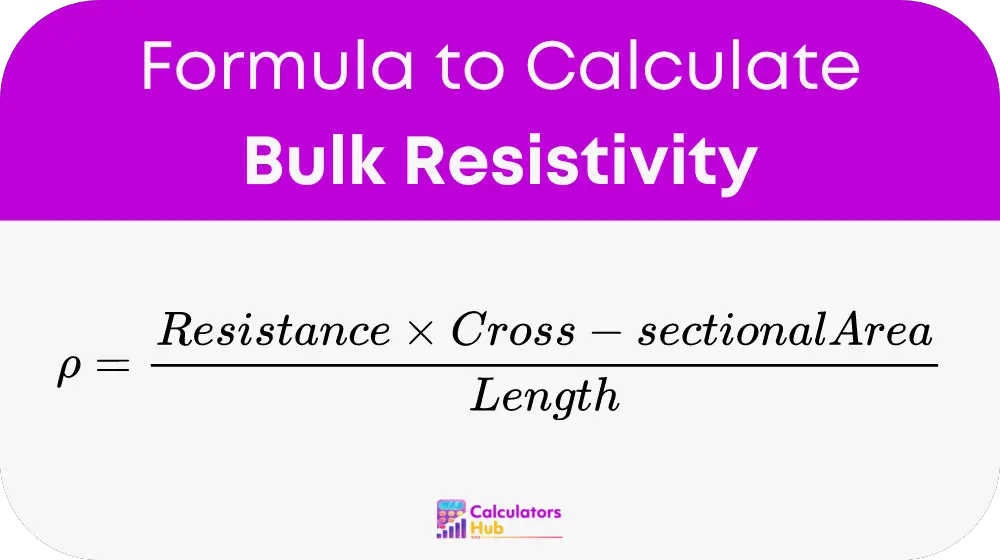The Bulk Resistivity Calculator is a tool used to determine the resistivity of a material, which measures how strongly that material opposes the flow of electrical current. Bulk resistivity is an essential property in electrical engineering, materials science, and electronics design, as it helps in understanding the electrical behavior of various materials, from conductors to insulators. The calculator uses parameters like electrical resistance, cross-sectional area, and length of the material to compute its resistivity.
By knowing a material’s bulk resistivity, engineers and scientists can evaluate its suitability for different applications, such as wiring, electrical components, or insulation. The bulk resistivity value is also crucial for analyzing how materials perform under different electrical stresses, such as in high-voltage environments.
Formula for Bulk Resistivity Calculator
The formula for calculating bulk resistivity (ρ) is as follows:

Where:
- Resistance (R) is the electrical resistance of the material, measured in ohms (Ω). Resistance represents how much the material opposes the flow of electrical current.
- Cross-sectional Area (A) is the area of the material’s cross-section perpendicular to the direction of current flow, measured in square meters (m²) or square centimeters (cm²).
- Length (L) is the length of the material through which the current flows, typically measured in meters (m) or centimeters (cm).
This formula gives bulk resistivity in ohm-meters (Ω·m) or ohm-centimeters (Ω·cm), depending on the units used for the parameters. A material with higher resistivity is more resistant to electrical current, making it an insulator, while lower resistivity indicates a conductor.
Breakdown of the Formula:
- Resistance (R) can be directly measured using an ohmmeter or calculated using Ohm’s Law:
R = Voltage / Current
Where voltage (V) is the potential difference applied across the material, and current (I) is the current flowing through the material. - Cross-sectional Area (A) is calculated for cylindrical materials as:
A = π * (d / 2)²
Where d is the diameter of the cylindrical sample. - Length (L) represents the distance over which the resistance is measured, usually in meters or centimeters.
For example, if you measure a wire with a resistance of 10 ohms, a cross-sectional area of 0.001 m², and a length of 2 meters, the bulk resistivity is calculated as:
Bulk Resistivity = (10 Ω * 0.001 m²) / 2 m = 0.005 Ω·m
This indicates that the material has a bulk resistivity of 0.005 ohm-meters.
Quick Reference Table
Here’s a reference table of typical bulk resistivity values for common materials, which can help users quickly estimate resistivity for different applications:
| Material | Bulk Resistivity (Ω·m) | Bulk Resistivity (Ω·cm) |
|---|---|---|
| Copper | 1.68 x 10⁻⁸ | 1.68 x 10⁻⁶ |
| Aluminum | 2.65 x 10⁻⁸ | 2.65 x 10⁻⁶ |
| Gold | 2.44 x 10⁻⁸ | 2.44 x 10⁻⁶ |
| Silicon (pure) | 640 | 64,000 |
| Glass | 10¹² to 10¹⁴ | 10¹⁰ to 10¹² |
| Rubber | 10¹³ to 10¹⁵ | 10¹¹ to 10¹³ |
This table provides a quick overview of the wide range of resistivity values, from conductive materials like copper to insulating materials like rubber and glass. It’s useful for comparing different materials in electrical and industrial applications.
Example of Bulk Resistivity Calculator
Let’s consider a practical example to illustrate the use of the Bulk Resistivity Calculator:
Suppose you are evaluating a wire made of an unknown material. You measure its electrical resistance as 15 ohms. The wire has a cross-sectional area of 0.002 m² and a length of 3 meters. Using the bulk resistivity formula:
Bulk Resistivity = (Resistance * Cross-sectional Area) / Length
Bulk Resistivity = (15 Ω * 0.002 m²) / 3 m = 0.01 Ω·m
In this case, the wire’s material has a bulk resistivity of 0.01 ohm-meters, which can help you identify the material or evaluate its suitability for specific electrical applications. By comparing this result with known resistivity values, you can determine whether the material is a conductor, semiconductor, or insulator.
Most Common FAQs
Bulk resistivity measures how strongly a material opposes the flow of electrical current. It depends on the material’s intrinsic properties, such as its atomic structure. Low bulk resistivity materials, such as copper and aluminum, are excellent conductors of electricity, while high resistivity materials like glass and rubber are use as insulators.
You measure resistance using an ohmmeter or by applying Ohm’s Law, which states that resistance equals the voltage divided by the current (R = V/I). This method provides the electrical resistance of a material, which is a crucial parameter in calculating bulk resistivity.
Bulk resistivity and electrical conductivity are inversely related. While resistivity measures how much a material resists the flow of current, conductivity measures how easily current flows through it. For example, a material with high resistivity has low conductivity, and vice versa. Metals like copper have low resistivity and high conductivity, making them ideal for electrical wiring.